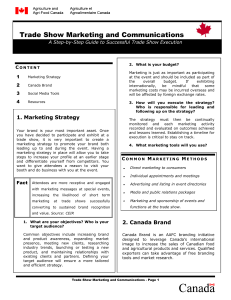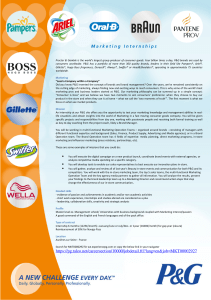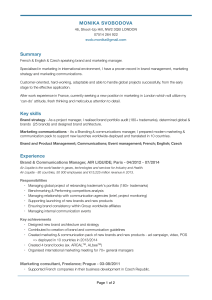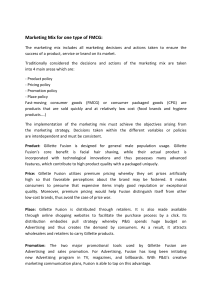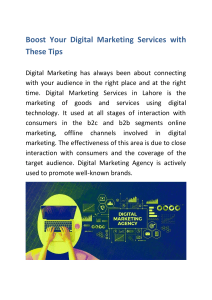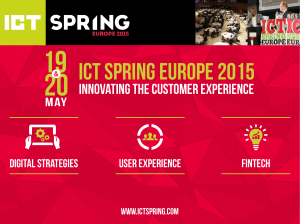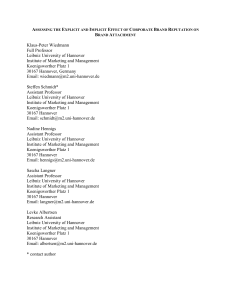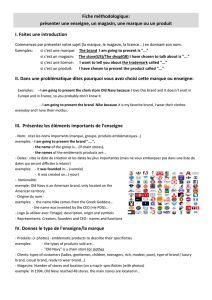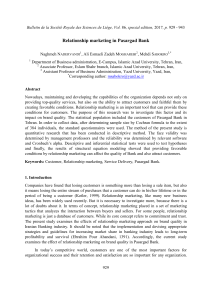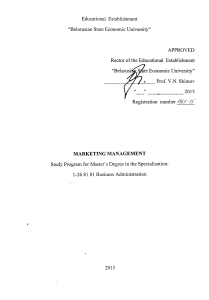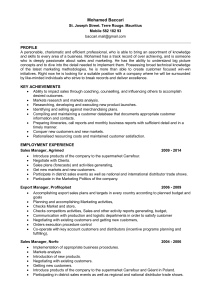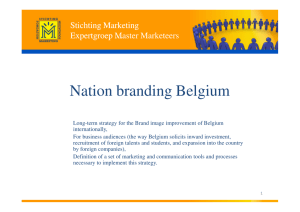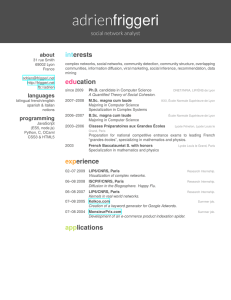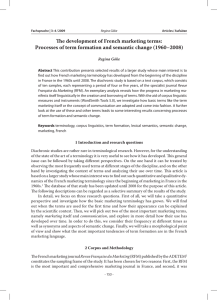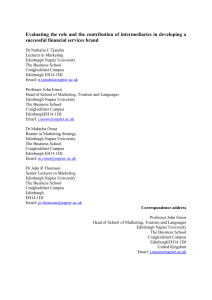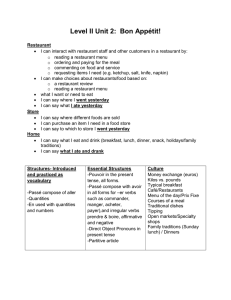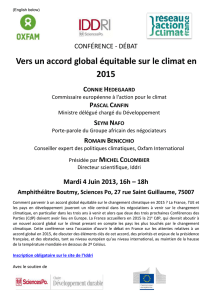The effect of exposure to operation event communication on the
publicité
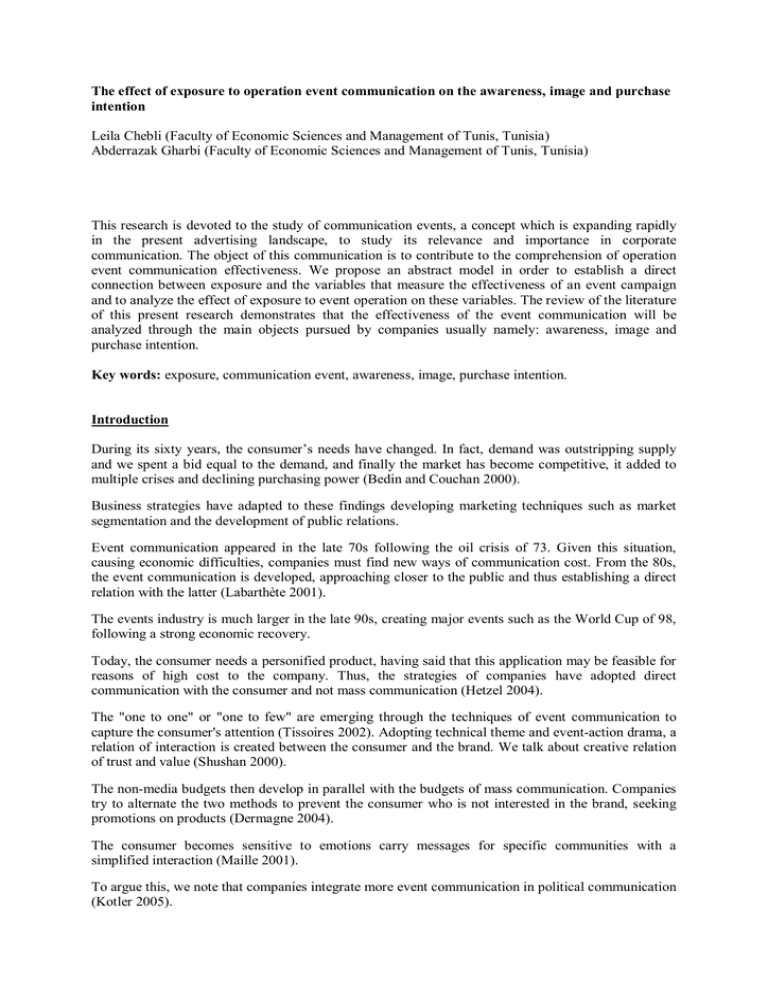
The effect of exposure to operation event communication on the awareness, image and purchase intention Leila Chebli (Faculty of Economic Sciences and Management of Tunis, Tunisia) Abderrazak Gharbi (Faculty of Economic Sciences and Management of Tunis, Tunisia) This research is devoted to the study of communication events, a concept which is expanding rapidly in the present advertising landscape, to study its relevance and importance in corporate communication. The object of this communication is to contribute to the comprehension of operation event communication effectiveness. We propose an abstract model in order to establish a direct connection between exposure and the variables that measure the effectiveness of an event campaign and to analyze the effect of exposure to event operation on these variables. The review of the literature of this present research demonstrates that the effectiveness of the event communication will be analyzed through the main objects pursued by companies usually namely: awareness, image and purchase intention. Key words: exposure, communication event, awareness, image, purchase intention. Introduction During its sixty years, the consumer’s needs have changed. In fact, demand was outstripping supply and we spent a bid equal to the demand, and finally the market has become competitive, it added to multiple crises and declining purchasing power (Bedin and Couchan 2000). Business strategies have adapted to these findings developing marketing techniques such as market segmentation and the development of public relations. Event communication appeared in the late 70s following the oil crisis of 73. Given this situation, causing economic difficulties, companies must find new ways of communication cost. From the 80s, the event communication is developed, approaching closer to the public and thus establishing a direct relation with the latter (Labarthète 2001). The events industry is much larger in the late 90s, creating major events such as the World Cup of 98, following a strong economic recovery. Today, the consumer needs a personified product, having said that this application may be feasible for reasons of high cost to the company. Thus, the strategies of companies have adopted direct communication with the consumer and not mass communication (Hetzel 2004). The "one to one" or "one to few" are emerging through the techniques of event communication to capture the consumer's attention (Tissoires 2002). Adopting technical theme and event-action drama, a relation of interaction is created between the consumer and the brand. We talk about creative relation of trust and value (Shushan 2000). The non-media budgets then develop in parallel with the budgets of mass communication. Companies try to alternate the two methods to prevent the consumer who is not interested in the brand, seeking promotions on products (Dermagne 2004). The consumer becomes sensitive to emotions carry messages for specific communities with a simplified interaction (Maille 2001). To argue this, we note that companies integrate more event communication in political communication (Kotler 2005). Studies have shown that companies today are looking for more goals only knowledge, but also want to act on the goals of branding and purchase intention (Michel 2003). Event communication can target its audience, broadcast messages and effectively mark the individuals. Elsewhere Anne (1992) distinguishes two types of exposure: direct exposure which includes individuals present directly at the place of the event and the indirect exposure that includes individuals exposed to the event through media (Television, Radio, Internet, display ...). In this context, it is to understand the role of event communication in the business communication and highlight the relation between exposure and the variables that determine the effectiveness of an operation event communication. Our goal is to work and then measure the influence of exposure (direct and indirect) on the awareness, image and purchase intention. This research then is to study: What is the effect of exposure to an operation event communication on the awareness, image and purchase intention? The answer to this question is a priority for any company looking to integrate event communication in its communication strategy. In this way, our research is part of a major concern for companies looking to learn and understand consumer’s behavior in this communication technique. Theoretical Framework: Conceptual model and research hypotheses The conceptual framework of this work is primarily based on the definition of event communication. We present successively thereafter variables in our conceptual model and research hypotheses. We postulate that the effectiveness of a campaign event communications will be measured through the awareness, image and purchase intention. We aim to know the extent of the event communication is considered as a specific tool in business communication, to explain and analyze the relevance of event communication. We measure the impact of exposure to an event operation on the variables studied. It is expected that exposure positively influence these variables. Definition and challenges of event communication The event is an integral part of the non-media communication (Lendrevie et al. 2003). This is a key tool in the strategy of the company (Farrelly et al. 1997). The event is a distinctive competence that differentiates a company from its competitors (Walliser 2003). According to a definition Decaudin (2003) off the media, is "the art of" communicate "with the consumer in areas traditionally outside the media and clearly allocated to advertising (radio, TV, press, billboards etc) and without the consumer really noticing the commercial nature of the contact. This "art", focused on the camouflage, has many faces: advertorials, editorial journalism "oriented" to consumer’s magazines, sponsorship, public relations, events, street marketing, promotions at the point of sale, corporate communications, lobbying. The event is aimed at different audiences: internal, or target the general public and demarcating advertising campaigns with high media coverage carried by relay information (journalists, opinion leaders and other influencers invited to the event) (Hertrich and Tribou 2004). The event allows you to meet and convey emotion, to share feelings and passions in common, all based on the latest technologies. In order to publicize and promote their products, companies use more event communication in their strategy and communication policy (Cornwell et al. 2001). The event is likely to affect a number of targeted individuals with common characteristics and thus create an impact with the communicative goals of the company. Event communication is “a generic name given to the actions of sponsorship and any communication technique based on the use of an event any existing or created specifically for the occasion. The approach is therefore to communicate across or through an event created voluntarily” (Decaudin 2003). “Sometimes it is presented as "a composite communication system implemented by an organization around the association of his name or brand to an event sociocultural" (sports scientist, artistic ...) (Baux 1991). It is a communication that is based on the proximity to the public and direct relation, in a given place at a definite time. It arouses the interest of the consumer, capturing his attention and causing him in curiosity. Event communication key areas such as: social and humanitarian events. According to Dubois and Jolibert (2005), it extends to other fields such as seminars, conventions, fairs, sporting events, cultural activities and associations, support for cultural and sporting activities. The research hypotheses The relation between exposure and brand image The affective dimension allows having an effect on the image of the company in part through the character of the event communication (Perlstein and Stake 1985). This campaign generates media coverage including over media, which will increase the visibility and change the image of the firm. Branding is defined as the set of perceptions that consumers may have about the brand, and are reflected in all brand associations and certain values (Keller 1993). For marketers, the event to deliver a social message that touches the viewer or listener in his aspiration to be part of a sporting or artistic social community (Perlstein and Stake 1985) aims. As for image transfer, it affects not only internal but also external targets (Meenagham and Grimes 1998). You can define the image of a brand, as the set of values and representations that people associated with her. According to (Desbordes et al. 2001), and reflected to give a good image, it must be not only desired by the target identity, that is to say close representations of consumers, but also have some credibility, that is to say, not too far from reality. It must also have personality based on originality. By partnering with an event, the company hopes to create in the mind of the target, a value transfer activity for the brand. Several studies have shown that the image of the event can be transferred to the marks at each event (Fleck-Dousteyssier 2004). According to Grohs (2004), branding is all the associations that are connected with the brand. The consumer must establish the association between positive image transferred by the event communication to the brand at the event. Different types of associations can be presented in the memorizing of consumers: functional and abstract. They can be classified into three categories: intrinsic and extrinsic attributes (that characterize a product or service), benefits (personal and cultural values that consumers attach to the attributes of the product or service) and attitudes toward the brand (Didellon and Ganassali 1996). Following these findings, we propose our first hypothesis: H1: "Exposure to an event has a positive impact on the brand image of the sponsor." The relation between exposure and brand awareness Research has been conducted to examine the effects on post-event memorizing and recognition ("recall and recognition"). However, according to Walliser (1994), there are several factors that can alter the relation between event communication and memorizing: Exposure conditions, the characteristics of the brand, the message characteristics, the characteristics of the audience and sponsorship in the communicational mix. This approach suggests that each brand gets a certain level of awareness, higher or lower, which will be increased shortly, after or during the event and then decreases again, close to the initial rate, a few weeks after the event. The brand awareness is the knowledge the public in general, and its prospects in particular (Desbordes 1999). The objective of the firm is to know and to talk about the brand with a more focused person. The motivation of the company, through increased awareness, is to ensure that the audience can remember the brand, it is able to retain its name, and so it is present in his mind as long as possible (Nanopoulos and Walliser 2000). The operation of event communication to be sustainable, it must register in time to facilitate the memorizing of the message, it must ensure the visibility of the brand to the audience directly but also indirectly the hearing to continue the memorizing while trying to rejuvenate permanently (Dublish et al. 1999). Thus, the company will stand out from its competitors and thus influence consumers in their choice. The element of memorizing allows a thrill factor at the presentation of an event, unlike advertising where the prospect is trying to escape, such as during a commercial break, the prospect will try zap the TV channel or do something else during this break. Furthermore, the emotion has a negative impact on memorizing (Pham and Vanhuele 1997). In the event, the prospect involved in the action and the experiences which improves the mouth. Word of mouth is a major determinant of the effectiveness of the event. Indeed, the testimony given following the assistance of an event provides credible information; its dissemination is then made spontaneously. Word of mouth and can promote the launch of a product or service, and to talk about the brand, which helps stimulate the dissemination of information. By interfering in the daily monotony, the event offers considerable appeal to those out of a newspaper brand, boost and highlight, valuing the company as well. An event manages to create relation between disparate social backgrounds, different age groups and groups of individuals spatially distant. It can boost the life of the brand and talking to him (Stipp and Schiavone 1996). These reasons allow the formulation of our second hypothesis: H2: "Exposure to an event induces an increase in brand awareness of the sponsor." The relation between exposure and purchase intention Boistel (2004), Meenaghan and Shipley (1999) point out that increased sales are usually a target for business sponsors at least in a second time. This current of thought argues that the main objectives sought by a company sponsoring an event is first bound an image lens (corporate) and the marketing objectives for the promotion of the brand, increase market share , sales, frequency of visits to retail outlets and finally media goals for achieving the target. The event strategy increases the purchasing and preference for the brand. The consumer is more sensitive to a brand when exposed to an event that shares his preferences and beliefs (Smith 1994). To do this, the event must be accompanied by other means of communication to support the brand and help increase the level of preference according to (Meenaghan 2001). When an event is of a commercial nature, the main objective is to increase sales. One strategy of a company through an event communication is to sell as much as possible and all phases of the event are intended to build brand awareness, enhance its image and encourage purchase. However, research has shown that there is no relation between direct influence and the evolution of sales and use of event communication (Miyazaki and Morgan 2001). The impact of the event operation on sales remains unknown. Therefore, according to Boistel (2004), the sales target even if it is not a determining factor in its effects and its relevance during an event operation over the image or awareness, it remains a very important factor for businesses. Indeed, the ultimate goal of a company after a successful event communication is increasing its sales. The event operation has an indirect effect on sales growth (Perkins 2003). Furthermore, studies have shown that more individuals will be exposed to the event and remain on the scene of the event, the more they will tend to buy the brand that is sponsoring the event. Indeed, according to Meenaghan (2001) the level of appreciation and affinity brands would increase sales to companies sponsoring the event. Moreover, some reports indicate that the event communication plays a catalytic role and trigger the sales process to some consumers (Morel 2002). Thus, all these factors will assess the profitability of a campaign event communications and thus increase sales and subsequently to an increase in market share. In light of the foregoing our third hypothesis is proposed: H3: "Exposure to an event positively influences purchase intention of the sponsor brand." The moderating role of congruence event/sponsor: the relation between exposure, congruence and image The image transfer is usually done when the event is well understood by the target (logical association between the event and the company's business), which will allow a favorable attitude towards the event (Valetta Giannelloni and Florence 1991) and it should also be visible. Indeed, the attitude reaction to the event is generated when the exposure of the individual (Giannelloni 1993). This obviously depends on the degree of integration of event communication in corporate strategy (Stipp and Schiavone 1996). Indeed, the image transfer occurs when there is cohesion and a matching between the event and the company, the values of the event shall correspond to those desired by the brand (Gwinner and Eaton 1999). There must be therefore a logical connection or a common denominator between the event and the company, the only condition for the success of a campaign event (Grohs 2004). The combination should be well received by the consumer so that there is a positive attitude towards the event and brand. (Dousteyssier Fleck 2004). For an interesting return on brand image, it is necessary that every event campaign is accompanied by an advertising campaign to establish a relation between the brand and the event and post-event to ensure its continuity. Thus, the more torque (event/sponsor) is perceived as relevant, the more it will improve the brand image. This is due to the transfer of positive images caused by the operation will thus to positively change the attitude towards the sponsor (Jagre et al. 2001). Thus, we propose our fourth hypothesis: H4: "The event/sponsor congruence has a moderating role between exposure and brand image." The moderating role of emotion: The relation between exposure, emotion and image It is also important to create an emotional intensity that is to say an emotion generated by the event itself. According to Lardinoit and Quester (2001), emotion cannot operate at an event when it is intense, positive and should allow the brand to associate. According to Hertrich and Tribou (2004), the effectiveness of event campaign is strongly influenced by the emotions that emerge from the event. Three conditions must be met for the emotions can emerge: the intensity, positivity and association with the brand. Emotions therefore are very important in the event communication strategy. Some entities, declare that it is the event that brings emotion to the brand. Furthermore, the emotional intensity is essential to contribute and make an impact that will improve the image of the company, if it has certain awareness (Walliser 1994). Indeed, it is the emotional content of the event that beautifies the image of the company, but it requires having a known beforehand (Lorent and Ferrand 1995). Hence, we deduce our fifth hypothesis: H5: "The emotional intensity towards an event plays a moderating role between exposure and the image of the sponsor brand." The moderating role of involvement: the relation between exposure, involvement and image There's also the involvement of the fan, which is important in the process of advertising persuasion and perceived image (Walliser 1994). The involvement, whether weak or strong then used to distinguish individuals by the attention and their interest in the event. It also helps to know better the event; the action of the company associated with it there and understands the relation between the event and the brand. More fans will be involved, the event will be perceived more positively and thus support the brand. The involvement in the event and positively influences the intensity of emotional reactions (Pham and Vanhuele 1997, Lardinoit 1997). Lardinoit and Quester (2001) define the involvement of the audience as "a sincere emotion caused by a strong and solid interest in a specific activity, resulting in the importance of this activity for the individual." The involvement of the viewer then indicates the extent to which it identifies a particular leisure activity by its commitment and adherence. (Meenaghan 2001). Thus, the more the audience is involved, the more it is aware of the event, and therefore, the more we understand the relation between the sponsoring company and the event and there will be a greater acceptance. Hence, the individual will be more involved, more attitude to the event will be favorable and image transfer will be positive (Cameron et al. 2001). The degree of involvement can influence the perception of the communication strategy by the event and therefore the reception of the message. This perception will be positive if individuals will be very involved to the sponsor (Stoquart 1991). It is important that consumers are involved in the operation of event communication to raise awareness, improve brand recognition, but also to stimulate interest and encourage them to communicate positively about the brand and thus contribute to the evolution of the image of the brand to target audiences. Thus, we propose to develop our sixth hypothesis as follows: H6: "Involvement in this event presents a moderating role between exposure and the image of the sponsor brand." The research model The literature review presented allows to propose a conceptual model of the variables that may be involved in the direct relation between exposure and the determinants of the effectiveness of a campaign event communications. This model summarizes the assumptions made in the preceding paragraphs. The involvement of each of these variables inserted is specified and its introduction into our research is warranted. Our research concerns the impact of exposure to an event operation communication on the awareness, image and purchase intention that are our dependent variables. These variables will allow us to assess the relevance of a campaign event communications. The independent variable in our model is the exposure to an event. Based on previous research, congruence, emotion and involvement influence the effectiveness and relevance of an event operation at least at the level of the image. That is why we have introduced these variables in our conceptual model as moderating variables. Relations studied in this research are depicted in the figure below: Congruence event/sponsor H4 Emotion Involvement H5 H6 H1 H2Exposure Image Awareness H2 H3 Purchase intention Figure 1. The effect of exposure to operation event communication on the awareness, image and purchase intention CONCLUSION, IMPLICATIONS AND FUTURE RESEARCH WAY The event communication is no longer a simple adjustment variable in communication budgets or simple media used as opportunities. It is now a key competitive advantage for the company (Chesnais 2001). As part of a tactical move, the event communication has forethought and is organized around strategic choices differ depending on the goals (Collins 1991). The main objective of this study is to propose a structural model to better explain the relation between exposure to an event and the variables of the effectiveness of a campaign event communication namely awareness, image and purchase intention. Trying to integrate moderating variables, such as congruence event/sponsor, emotion and involvement studied in the literature and involved in the relation between exposure and image. Our goal is to enrich the theory of modeling consumer behavior. The literature has shown that event communication has a role to play in the communication strategy of the company. Indeed, multifaceted and versatile, the event communication surpassed the achievement of a single event. It’s now creating the event in the event, to give the event a real continuity in time and space, associated with the communication mix (Firmin Didot 2005). Thus, exposure strongly influences consumer behavior and more precisely its purchasing behavior by changing attitudes (Laroche et al. 2001). From this observation, it has been shown theoretically that exposure during a campaign event, is effective in changing consumer behavior, especially on the awareness, image and purchase intention. The events know their moment of glory, and certainly are in this maturity cycle. Developed by "major companies" abroad, supervised by professionals and experts, the event communication is an investment company for more than spending. Thus, the company has a very special relation with the event and its participants. The company integrates the event in its capital (Speed and Thompson 2000). Beyond the undeniable pressures and reports inescapable force the actors maintain strong relationships and invent unique partnerships (Hetzel 2002). Faced with the constraints of the sector, uncertainty of the results, the needs of the various parties involved, the event-free and works as an unstable radical which seeks to find the balance point (Quester and Thompson 2001). The ideal evolution would be a sharing of financial, human and social values among business partners and organizers of the event (Igalens 1991). Proximity search, commitment and trust are, unmade and revolve around the event. It is however difficult to achieve perfect balance in this ever-changing society, driven by societal and ownership issues pronounced (Collins 1991). Capitalistic issues that a good indicator is the gradual increase in the purchasing departments in the choice of event providers. Between economic rationality and creativity, there is a new event to conquer territories (Piquet 1998). Therefore, this work will allow us to establish a relation between exposure and the variables that measure the effectiveness and appropriateness of a campaign event communications. This research, we would also study the impact of exposure on these variables, and to better understand the target customers and identify their diverse needs. This study opens up broad avenues of research. We will remember them: -Conduct an empirical study to verify the validity of the theory to apply it to other fields in marketing. Make a qualitative study to include advantages, to feel the impressions of consumers and their feelings about this mode of communication. -Knowing precisely the specific needs of consumers, collect their opinions and attitudes about the practice of this kind of technique. Bibliography Anne, F. (1990). Mesure de l'efficacité du sponsoring : une analyse des effets intermédiaires sur l'audience directe de l'événement. Actes du congrès, Association Française de Marketing, La Baule, 121-148. Anne, F. (1992). La mesure de l’efficacité du sponsoring. Revue Française du Marketing, 138, 123136. Arcan, J.C., Piquet, S. & Rouzaud, P. (1994). Une action de mécénat humanitaire exemplaire: la collecte de radiographies périmées. Revue Française du Marketing, 147, 105-109. Bagozzi, R.P. (1982). A field investigation of causal relations among cognitions, affect, intentions and behavior. Journal of Marketing Research, 19 (4), 562-584. Bagozzi, R.P. (1984). A prospectus for theory construction in marketing. Journal of Marketing, 48 (1), 11-29. Baux, P. (1991). Modèles de persuasion et parrainage sportif. Revue Française du Marketing, 131(1), 51-67. Bedin, F. & Couchan, L. (2000). L’événement : la communication du XXIème siècle. LPM. Bénavent, C. & Chotard, S.F. (1991). Une approche cognitive des facteurs de réussite des nouveaux produits. Recherche et Applications en Marketing, 6 (4), 3-26. Boistel, P. (2004). La communication événementielle comme vecteur de motivation: le rôle des conventions réunissant l’encadrement. 17es journées nationales des IAE, Lyon. Boistel,P. (2004). Quelle place occupe la communication évènementielle dans la stratégie de communication ?. 1ère thématique sur la communication marketing, Nord- Est de la France sur la communication marketing, 9. Brochand, B. & Lendrevie, J. (2001). Le nouveau Publicitor. Paris, 5ème éditions Dalloz. Cameron, G., Joiner, C. & Levin, A.M. (2001). The Impact of Sports Sponsorship an Consumers’Brand Attitudes and Recall: The Case of Nascars Fans. Journal of Current Issues and Research in Advertising, 23 (2), 23-31. Cegarra, J.J. (1990). Sponsorisme et mécénat. Direction et Gestion, 124 (125), 73-80. Chesnais, R. (2001). Histoire de médias. Editions Nautilus. Chouchan, L. (2000). L’événement, la communication du XXIe siècle. Paris, Les Presses du Management. Collins, M. (1991). Global corporate philanthropy-marketing beyond the call of duty?. European Journal of Marketing, 27 (2), 46-58. Cornwell, T.B., Pruit, S.W. & Van Ness, R. (1997). Long-term recall of sponsorship sources. An empirical investigation of stadium and sport café audiences. Asia-Australia Marketing Journal, 5 (1), 45-57. Cornwell, T.B., Pruitt, S.W. & Van Ness, R. (2001). The value of winning in motorsports: sponsorship-linked marketing. Journal of Advertising Research, 41 (1), 17-31. Darpy, D., Fleck-Dousteyssier, N. & Roux, E. (2005). La congruence dans le parrainage : définition, rôle et mesure. Actes de l’Association Française du Marketing, 6ème congrès international des tendances du marketing Nancy, Paris. Décaudin, J.M. (2003). La communication marketing, concepts, techniques, stratégies. Paris, Economica. Deimel, K. & Zentes, J. (1991). Mécénat, encouragement à la culture, sponsoring – De nouvelles chances pour le marketing. Revue Française du Marketing, 131 (1), 13-29. Derbaix, C., Gérard, P. & Lardinoit, T. (1994). Essai de conceptualisation d’une activité éminemment pratique: le parrainage. Recherche et Applications Marketing, 9 (2), 43-67. Dermagne, P. (2004). Quelle opération pour quelle cible?. In Croissance Actualités, n°24. Desbordes, M. (1999). Marketing du sport. Paris, Economica. Desbordes, M., Ohl, F. & Tribou, G. (2001). Marketing du sport. Paris, Economica. Didellon, L. & Ganassali, S. (1996). Le transfert comme principe central du parrainage. Recherche et Applications en Marketing, 11 (1), 37-47. Dowling Granarne, R. (1986). Managing your corporate images. Industrial Marketing Management, 15, 109-115. Dublish, S., Nicholls, J.A.F. & Roslow, S. (1999). Brand recall and brand preference at sponsored golf and tennis tournaments. European Journal of Marketing, 33, 365-386. Dubois, P.L. & Jolibert, A. (2005). Le marketing, fondements et pratiques. Paris, Economica. Eaton, J. & Gwinner, K. P. (1999). Building brand image through event sponsorship: The role of image transfer. Journal of Advertising, 28 (4), 47-57. Ehrenberg, A. (1991). Le culte de la performance. Paris, Calmann-Lévy. Farrelly, F.J., Quester, P.G. & Smolianov, P. (1997). The Australian Cricket Board (ACB): mapping corporate relations. Corporate Communications: An International Journal, 3 (4), 150-155. Ferrand, A. & Lorent, A. (1995). La communication par l’événement sportif : entre l’émotion et rationalité, in, Sport et management, de l’éthique à la pratique. Revue EPS, 280-294. Firmin Didot, C. (2005). Le mécénat, aubaine pour les institutions culturelles et pour les entreprises. In Télérama, (2883), 58-62. Fleck-Dousteyssier, N. (2004). Une application des modèles de traitement de l’information au parrainage : le rôle de la congruence. Actes de la 1ère journée thématique sur la communication marketing, du Nord-Est de la France. Fleck-Dousteyssier, N. (2003). Effet du parrainage sur l’image de marque : le rôle de la congruence, 325. Giannelloni, J.L. & Valette-Florence, P. (1991). La mesure de l’efficacité de la communication par l’événement: une approche structurelle. Actes du 7e Congrès de l’Association Française du Marketing, 252-276. Giannelloni, J.L. (1993). L’influence de la communication par l’événement sur la nature de l’image de l’entreprise. Recherche et Applications en Marketing. Gregory, P. (1984). Sponsoring et mécénat : instruments de communication institutionnelle. Revue Française de Gestion, 163-175 Grimes, E. & Meenagham, T. (1998). Focusing commercial sponsorship on the internal corporate audience. International Journal of Advertising, 17 (1), 51-74. Grohs, R. (2004). An assessment of factors driving the strength of image transfer in Sports Sponsorships: Conceptual Analysis and Empirical Study. 1st French International Research Day on Marketing Communications. Hayes, P. & Otker, T. (1988). Evaluation de l’efficacité du sponsoring. Expériences de la Coupe du Monde de Football de 1986. Revue Française du Marketing, 118 (3), 13-40. Hertrich, S. & Tribou, G. (2004). Sponsoring sportif : la place de l’éthique. GREFIGE/AFM, Université de Nancy II. Hetzel, P. (2002). Planète conso, Marketing expérientiel et nouveaux univers de consommation. Paris, Éditions d’Organisation. Hetzel, P. (2004). Le marketing relationnel. PUF. Igalens, J. (1991). Le marketing social, Encyclopédie du Management. Paris, Vuibert. Jagre, E., Watson, J.G. & Watson, J.J. (2001). Sponsorship and Congruency Theory: a Theoretical Framework for Explaining Consumer Attitude and Recall Event Sponsorship. Advances in Consumer Research, 28, 439-445. Jallat, F. & Mestressat, A. (1995). Une analyse de la communication événementielle au sein de l’entreprise : le mécénat comme vecteur privilégié de motivation interne. Revue Française du Marketing, 151. Johar, G.V. & Pham, M.T. (1999). Relatedness, prominence and constructive sponsor identification. Journal of Marketing Research, 36, 299-312. Kapferer, J.N. (1988). Maîtriser l'image de l'entreprise: le prisme d'identité. Revue Française de Gestion, 71, 76-82. Keller, K. L. (1993). Conceptualizing, measuring and managing customer-based brand equity. Journal of Marketing, 57, 1-22. Kotler, P. (2005). Le marketing de demain. Les Échos. La Tour Michael, S. & Zahl am Shaker, A. (1987). Corporate social responsibility and organizational effectiveness: a multivariate approach. Journal of Business Fthics, 6 (6), 459-467. Labarthète, A. (2001). La communication événementielle. Demos. Lardinoit, T. (1997). Réaction attitudinale des téléspectateurs aux campagnes de parrainage: étude de l’incidence de la conjonction des parrainages terrain et T.V. Actes du 13e Congrès de l’Association Française du Marketing,Toulouse, 668-697. Lardinoit, T. & Quester, P.G. (2001). Attitudinal Effects of Combined Sponsorship and Sponsor’s Prominence on Basketball in Europe. Journal of Advertising Research, 48-57. Laroche, M., Nyeck, S., Perreault, S. & Pons, F. (2001). Role of sporting events as ethnoculture’s emblems: impact of acculturation and ethnic identity on consumers orientation toward sporting events. Sports Marketing Quaterly, 132-146. Lazar, J. (1992). La science de la communication. Paris, PUF, Que sais-je ?. Leclerc, T. (2005). Les annonceurs doutent de l’efficacité de la visibilité média. CBNews, 821, 14. Lehu, J.M. (2004). L’encyclopédie du marketing. Paris, Editions d’Organisation. Lendrevie, J., Lévy, J. & Lindon, D. (2003). Mercator. Paris, 7ème Éditions Dalloz. Maffesoli, M. (1990). Au creux des apparences. Paris, Plon. Maille, V. (2001). L'influence des stimuli olfactifs sur le comportement du consommateur : un état de recherche. Recherche et applications en marketing, 16, 2. Meenaghan, T. (2001). Understanding sponsorship effects. Psychology and Marketing, 18 (2), 95-122. Meenaghan, T. & Shipley, D. (1999). Media effect in commercial sponsorship. European Journal of Marketing, 33 (4), 328-347. Meenaghan, T. (2001). Sponsorship and Advertising: A Comparaison of Consumer Perception. Psychology & Marketing, 18 (2), 197-215. Michel, H. (2003). La maîtrise du rendement de la communication commerciale nouveaux challenges ?. Revue Française du Marketing, 193 (5), 145-158. Miyazaki, A.D. & Morgan, A.G. (2001). Assessing market value event sponsoring: Corporate Olympic sponsorships. Journal of Advertising Research, 41 (1), 9-15. Morel, P. (2002). La communication d’entreprise. Paris, 2éme édition, Vuibert. Nanopoulos, P. & Walliser, B. (2000). Qui a gagné la Coupe du Monde 1998? Déterminants et importance de l’association durable des sponsors à l’événement. Actes du 16e Congrés de l’Association Française du Marketing (AFM), Montréal, 723-734. Perkins, W. (2003). L’événement, une communication sans limites ou Presque. Paris, Histoire d’être. Perlstein, J. & Piquet, S. (1985). La communication dans l’événement : sponsoring et mécénat. Revue Française du Marketing, 105, 31-40. Perrotte, D. (2005). La France cède à la vogue des fondations d’entreprise. Les Échos, 12. Pham, M. & Vanhuele, M. (1997). Analyzing the Memory Impact of Advertising Fragments. Marketing Letters, 8 (4), 407-417. Piquet, S. (1998). Sponsoring et communication sociale. Revue Française de Gestion, 118. Pope, N.K.L. (1998). Consumption values, sponsorship awareness, brand and product use. Journal of Product & Brand Management, 7 (2), 124-136. Pothain, V. (2003). Grands Records est une métaphore de ce que nous sommes. L’expression, Cap Gemini Ernst & Young,36-37. Quester, P.G. & Thompson, B. (2001). Advertising and promotion leverage on arts sponsorship effectiveness. Journal of Advertising Research, 41 (1), 33-47. Rosé, J.J. (1986). L'art pour l'art. De Mécène aux sponsors. Flammarion. Rousseaux, N. (1988). Le hit-parade du mécénat. l’Expansion, 80-91. Schiavone, N.P. & Stipp, H. (1996). Modeling the impact of Olympic sponsorship on Corporate Image. Journal of Advertising Research, 36, 4, 22-28. Smith, C. (1994). The new corporate philanthropy. Harvard Business Review, 105-116. Speed, R. & Thompson, P. (2000). Determinants of Sports sponsorship Response. Journal of the Academy of Marketing Science, 226-228. Stoquart, J. (1991). Le marketing événementiel. Paris, Editions d’organisation. Tarde, G. (1989). L’opinion et la foule (1901). Paris, PUF, Collection recherches politiques. Tissoires, D. (2002). Guide pratique à l’usage des organisateurs de colloques, journées d’études, séminaires. Editions du puits fleuri. Tribou, G. (2003). Sponsoring : le retour symbolique sur investissement. Communication au quatrième congrès de la Société Française de Management du Sport. Tribou, G. (2004). Sponsoring sportif. Paris, Economica. Walliser, B. (2003). L’évolution et l’état de l’art de la recherche internationale sur le parrainage. Recherche et Applications en Marketing, 18 (1), 65-94. Walliser, B. (1994). Les déterminants de la mémorisation des sponsors. Revue Française du Marketing, 150, 83-95. Westphalen, M.H. (2003). Le Communicator, Le guide opérationnel pour la communication d’entreprise. Paris, Dunod.
